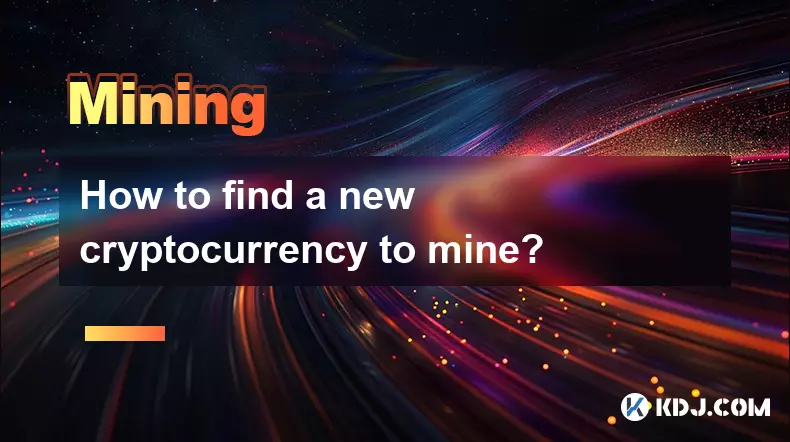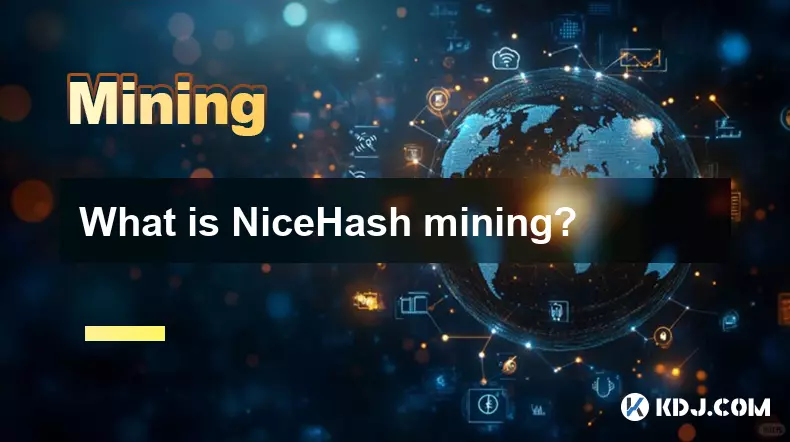-
 bitcoin
bitcoin $103128.103252 USD
-3.33% -
 ethereum
ethereum $3437.127692 USD
-4.86% -
 tether
tether $0.999700 USD
-0.02% -
 xrp
xrp $2.403993 USD
-5.73% -
 bnb
bnb $961.374676 USD
-4.11% -
 solana
solana $154.938665 USD
-8.18% -
 usd-coin
usd-coin $1.000113 USD
0.03% -
 tron
tron $0.298122 USD
0.30% -
 dogecoin
dogecoin $0.172428 USD
-5.76% -
 cardano
cardano $0.557625 USD
-7.13% -
 hyperliquid
hyperliquid $38.740701 USD
-6.51% -
 chainlink
chainlink $15.306051 USD
-7.51% -
 bitcoin-cash
bitcoin-cash $507.558648 USD
-3.26% -
 stellar
stellar $0.281899 USD
-6.74% -
 unus-sed-leo
unus-sed-leo $9.241811 USD
0.57%
How to find a new cryptocurrency to mine?
Research early-stage PoW cryptocurrencies with low market cap, active development, and fair launches to find promising mining opportunities.
Nov 04, 2025 at 09:18 am

Finding Promising Cryptocurrencies for Mining
1. Research active blockchain networks that are still in early stages of adoption. Newer projects often offer higher mining rewards to attract participants and secure their network. Platforms like CoinGecko or CoinMarketCap list emerging tokens with low market capitalization, which could indicate potential growth.
2. Analyze the consensus mechanism of each cryptocurrency. Not all digital assets can be mined—only those using Proof-of-Work (PoW) allow miners to validate transactions and earn block rewards. Look for coins using algorithms such as SHA-256, Ethash, or newer ones like RandomX or KawPow, depending on your hardware capabilities.
3. Evaluate mining difficulty and network hash rate trends. A sudden spike in hash rate may signal growing interest, but it also increases competition. Conversely, a stable or declining difficulty might provide better profitability for individual miners, especially if you're operating with limited resources.
4. Check community activity and development progress. Active GitHub repositories, regular updates, and strong social media presence on platforms like Twitter, Telegram, or Discord suggest a committed team and long-term vision. Avoid projects with little transparency or stagnant codebases.
5. Use mining calculators to estimate potential returns. Input your hardware’s hashrate, power consumption, electricity cost, and pool fees to project daily earnings. Compare multiple coins to identify which offers the best return on investment based on current market prices and network conditions.
Hardware Compatibility and Algorithm Matching
1. Determine whether your equipment supports the target coin's mining algorithm. GPUs work well with memory-hard algorithms like Ethash or ProgPOW, while ASICs dominate SHA-256-based networks such as Bitcoin. Some newer cryptocurrencies are designed to be ASIC-resistant to promote decentralization.
2. Explore multi-algorithm mining software that allows switching between different PoW chains. Tools like NBMiner or GMiner support various algorithms, enabling miners to pivot quickly when more profitable opportunities arise without changing hardware.
3. Consider energy efficiency when selecting a mineable asset. High-power consumption can erase profits even if the coin appears lucrative at first glance. Optimize setup by choosing coins that align with efficient hardware use and lower electricity costs per kilowatt-hour.
4. Monitor firmware and driver updates for your mining rigs. Manufacturers frequently release optimizations that improve performance across specific algorithms, giving you a competitive edge in solving blocks faster than others on the same network.
5. Join mining forums and Reddit communities like r/CryptoCurrency or r/MoneroMining to learn about real-world experiences. Users often share insights on undervalued coins, unexpected forks, or temporary network imbalances that create short-term mining advantages.
Assessing Longevity and Network Security
1. Investigate the coin’s emission schedule and total supply cap. Coins with predictable inflation rates and transparent distribution models tend to maintain miner incentives over time. Be cautious of hyperinflationary designs that flood the market with new tokens, reducing value per unit.
2. Review node distribution and wallet availability. A healthy number of full nodes indicates robust network security and decentralization. Widespread wallet support across desktop, mobile, and hardware devices reflects broader adoption potential.
A coin with concentrated mining pools poses centralization risks, making it vulnerable to 51% attacks. Prioritize networks where no single mining entity controls over 30% of the hash rate.3. Examine exchange listings and trading volume. While not all mineable coins need immediate exchange access, having liquidity options helps convert mined tokens into stablecoins or other cryptos. Low-volume markets may lead to slippage and difficulty cashing out.
4. Look into developer funding and treasury models. Projects that allocate a portion of block rewards to fund ongoing development show commitment to sustainability. This reduces the risk of abandonment after initial hype fades.
5. Track audit reports and smart contract verification, especially for hybrid chains combining mining with DeFi features. Independent security audits from firms like CertiK or Hacken add credibility and reduce exposure to exploits or backdoors.
Common Questions About Mining New Cryptocurrencies
What tools help discover newly launched mineable coins?Aggregators like WhatToMine, MinerStat, and CryptoCompare offer filters for recently listed PoW coins. RSS feeds from mining pools such as F2Pool or Nanopool often announce support for new chains shortly after launch.
How do I know if a new cryptocurrency is pre-mined or fair-launched?Check the genesis block and early transaction history. In a fair launch, mining begins publicly with no pre-allocated reserves. If large amounts were distributed before public awareness, it likely involved a pre-mine, which may affect fairness and future price stability.
Can cloud mining be used for new cryptocurrencies?Most cloud mining providers focus on established coins due to demand and infrastructure requirements. Newer coins typically lack this support, requiring personal hardware investment for participation.
Is solo mining viable for new cryptocurrencies?Solo mining success depends on your hash rate relative to the network. For very small networks, it might be feasible, but joining a pool usually provides more consistent payouts despite shared rewards.
Disclaimer:info@kdj.com
The information provided is not trading advice. kdj.com does not assume any responsibility for any investments made based on the information provided in this article. Cryptocurrencies are highly volatile and it is highly recommended that you invest with caution after thorough research!
If you believe that the content used on this website infringes your copyright, please contact us immediately (info@kdj.com) and we will delete it promptly.
- XRP ETF Approved, Bitcoin Stabilizes, Crypto Updates: What's Next?
- 2025-11-12 19:00:00
- Evercade Alpha Taito Edition: Bartop Behemoth or Redundant Retro?
- 2025-11-12 19:15:02
- Zcash in 2025: Buy, Hodl, or Bye-Bye?
- 2025-11-12 19:00:02
- XRP Tundra's Audited Presale: Riding the Wave of Transparency in Crypto
- 2025-11-12 19:00:02
- MEXC, Chiliz, CHZ Frenzy: A Million-Dollar Fan Fiesta!
- 2025-11-12 19:05:01
- Visa, Stablecoin, and USDC: A New Era of Payments?
- 2025-11-12 19:40:01
Related knowledge

What is the block reward in mining?
Nov 06,2025 at 12:35am
Understanding Block Rewards in Cryptocurrency Mining1. The block reward is the incentive miners receive for successfully validating and adding a new b...

How do mining algorithms work?
Nov 06,2025 at 04:59am
Mining Algorithms and Their Role in Blockchain Networks1. Mining algorithms serve as the backbone of blockchain consensus mechanisms, ensuring that tr...

What is NiceHash mining?
Nov 06,2025 at 07:40am
NiceHash mining refers to the process of renting out computational power to individuals or organizations seeking to mine cryptocurrencies without owni...

Does an antivirus program affect mining?
Nov 05,2025 at 09:29pm
Understanding Decentralized Exchanges in the Crypto Ecosystem1. Decentralized exchanges (DEXs) operate without a central authority, allowing users to ...

What is the history of Bitcoin mining?
Nov 05,2025 at 08:15pm
Within the fast-moving world of cryptocurrency, new developments emerge daily, reshaping how investors, developers, and institutions interact with dig...

How is the energy consumption of mining justified?
Nov 05,2025 at 10:20pm
Energy Consumption in Cryptocurrency Mining1. The energy consumption associated with cryptocurrency mining has drawn significant attention from enviro...

What is the block reward in mining?
Nov 06,2025 at 12:35am
Understanding Block Rewards in Cryptocurrency Mining1. The block reward is the incentive miners receive for successfully validating and adding a new b...

How do mining algorithms work?
Nov 06,2025 at 04:59am
Mining Algorithms and Their Role in Blockchain Networks1. Mining algorithms serve as the backbone of blockchain consensus mechanisms, ensuring that tr...

What is NiceHash mining?
Nov 06,2025 at 07:40am
NiceHash mining refers to the process of renting out computational power to individuals or organizations seeking to mine cryptocurrencies without owni...

Does an antivirus program affect mining?
Nov 05,2025 at 09:29pm
Understanding Decentralized Exchanges in the Crypto Ecosystem1. Decentralized exchanges (DEXs) operate without a central authority, allowing users to ...

What is the history of Bitcoin mining?
Nov 05,2025 at 08:15pm
Within the fast-moving world of cryptocurrency, new developments emerge daily, reshaping how investors, developers, and institutions interact with dig...

How is the energy consumption of mining justified?
Nov 05,2025 at 10:20pm
Energy Consumption in Cryptocurrency Mining1. The energy consumption associated with cryptocurrency mining has drawn significant attention from enviro...
See all articles


























![[4K 60fps] no care by crashpancake2 (1 Coin) [4K 60fps] no care by crashpancake2 (1 Coin)](/uploads/2025/11/12/cryptocurrencies-news/videos/6913a8862890b_image_500_375.webp)















































